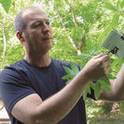Non-native plants introduced to new habitats can have significant ecological impact. In many cases, even though they interact with the same community of potential herbivores as their new native competitors, they regularly receive less damage. Plants produce secondary metabolites in their leaves that serve a range of defensive functions, including resistance to herbivores and pathogens. Abiotic factors such as nutrient availability can influence the expression of defensive traits, with some species exhibiting increased chemical defense in low-nutrient conditions. Plants in the genus Lonicera are known to produce a diverse array of these secondary metabolites, yet non-native Lonicera species sustain lower amounts of herbivore damage than co-occurring native Lonicera species in North America. In this study, we searched for evidence of biochemical novelty in non-native species, and quantified its association with resistance to herbivores. In order to achieve this, we evaluated the phenolic and iridoid glycoside profiles in leaves of native and non-native Lonicera species grown under high and low fertilization treatments in a common garden. We then related these profiles to naturally occurring herbivore damage on whole plants in the garden. Herbivore damage was greater on native Lonicera, and chemical profiles and concentrations of selected putative defense compounds varied by species. Geographic origin was an inconsistent predictor of chemical variation in detected phenolics and iridoid glycosides (IGs). Overall, fertilization did not affect herbivore damage or measures of phenolics or IGs, but there were some fertilization effects within species. While we cannot conclude that non-natives were more chemically novel than native Lonicera species, chemical defense profiles and concentrations of specific compounds varied by species. Reduced attraction or deterrence of oviposition, specific direct resistance traits, or a combination of both may contribute to reduced herbivory and competitive advantages for non-native Lonicera in North America.
Available at: http://works.bepress.com/don-cipollini/19/
